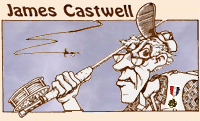|
Armed with this information, you really my be
able to select the best fly-line for fishing lakes,
at least for the type of fishing you do. However,
this will pertain only to floating lines, or lines
that float but have a sinking tip. Anyway, some part
of the line must float for this to be relevant. If
you use only intermediate or sinking lines then you
are still on your own, sorry.
I came by this information at a show in Salt Lake City,
Utah a few years ago, one of those big fly-fishing sports
shows, most of the name tackle producers from the world
were there, and me. A major rod maker from Europe was
asking me if he should see about having some fly-lines
made with his name on them, and if so, who should make
them. I told him I had no idea how good a thought it
was, but I did know some of the line makers and would
be glad to look into it for him.
A big outfit I talked to wanted a initial order that
was way out of line for my rod maker buddy so I went
to a smaller company. He was willing to make a lesser
number so the three of us went up to one of those huge
casting ponds they have at such shows. These are about
thirty feet wide, eighty feet long and four inches
deep. We had two rods with two of the line makers
products on them.
My rod-maker pal cast one out about sixty feet or so,
but it was a very unusual cast. The line went out very
straight, it looked like a line drawn on paper. Not a
wiggle in it. I could see I may be in for an education.
How right I was.
He made the cast and put the rod down, tip pointing right
at the line and didn't touch it again. I had no idea of
what he was doing, so I just kept my trap shut. Soon,
quite soon in fact, the line started to form little
serpentine wiggles in it. The longer it stayed floating
there the more it got and the worse they became. He
said that type of line would definitely not be accepted
in Europe. He reeled it up and cast the other rod, doing
just like he had done the first one, perfectly straight,
and put that rod down also. Again, waiting, we saw the
line do the same thing. As the cooler water temperature
affected the line the little wiggles would form. This
line too was rejected.
He explained to the line maker that he needed a floating
line that would not 'recoil' like that when it cools.
That, when using a floating line on a lake, if you want
to keep control, you need a constantly rather direct
connection with the fly. When the line creates wiggles,
you must always be retrieving little amounts of line to
keep that connection. That means you are always bringing
your line in. Not really the object at that time.
So there you have it. The best line for a lake might
be the one that does not 'recoil' as it lies on the water.
I have no idea of who's or which lines will perform best
on that type of test, but, at least now you know of yet
one more thing to look for when choosing a fly-line for
lakes. And once again, I have left you with more questions
than answers, sorry about that. But, heck, if I knew
everything, I wouldn't be doing this for a living.
~ James Castwell
|



